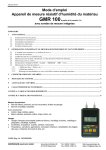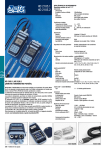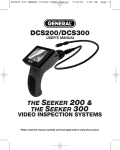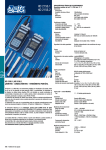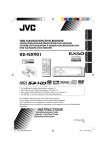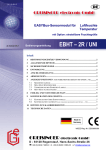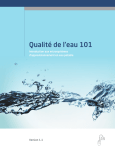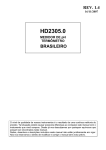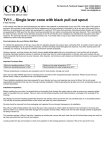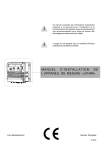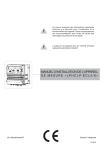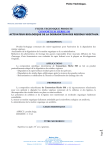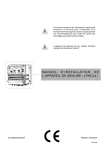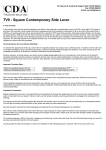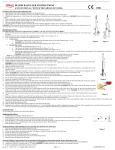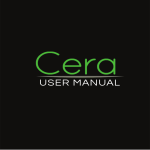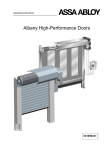Download Operating Manual for Digital-pH
Transcript
H24.0.01.6C-08 page 1 of 4 Operating Manual for Digital-pH-Meter GPH 014 S pecification: Measuring range: Resolution: Accuracy (device only): pH-electrode: Input resistance: Display: Working temperature: Relative humidity: Power supply: Battery service life: Low battery warning: Dimensions: Weight: Calibrating: EMC: 0,00 to 14,00 pH 0,01 pH ± 0,02 pH ±1 digit (at nominal temperature = 25°C) pH-electrode GE014 (standard electrode, incl. in scope of supply), plug in via front-side electrode socket (Cinch). GE 014: combined measuring and reference electrode with refillable 3 mol-KCl-electrolyte. measuring range: 2 to 12 pH, temperature: 5 to 45°C, conductivity: >200 µS/cm. For permanent measurements in a highly alkaline environment, special electrodes have to be used. (Please refer to special accessories) approx. 10 12 Ohm approx. 13 mm high, 3½ digit LCD 0 to 45°C 0 to 80 % r.F. (non condensing) 9V-battery Type IEC 6F22 (included in scope of supply) approx. 200 h Automatic; "BAT" displayed in case of low battery voltage approx. 106 x 67 x 30 mm (H x W x D) approx. 200g (incl. battery and electrode GE014) 3 turning knobs for: 1. temperature compensation 0 to 90°C 2. pH 7-value 3. pH X-value (e.g. pH 1,09, pH 4, pH 10 or pH 12, depending on working environment) The device corresponds to the essential protection ratings established in the Regulations of the Council for the Approximation of Legislation for the member countries regarding electromagnetic compatibility (2004/108/EG). additional errorr: <1% Point s to be observed during operation a.) In case of low battery voltage "BAT" is displayed; make sure to exchange battery immediately as too low an operation voltage may lead to incorrect measuring results. We recommend to take out battery if device will not be operated for some time or storaged over 50°C. Please note: If the battery voltage falls even lower the voltage may not be sufficient for "BAT" to be displayed so that there will be no "BAT" indication although the battery has been used up. We recommend to make it a rule to always check the battery if the values indicated seem to be completely out of range. b.) Make sure to maintain device an electrode properly and to operate it in accordance with the specification listed (do not throw, knock etc.). c.) The electrode must be stored in 3 mol/l KCl (ours type: KCl3M), in order to avoid drying out (excluded GE103). d.) Before measuring the protection-cap has to be removed. e.) Our pH-electrodes can be used in a degree range from 90° to ±45° compared to horizontal Disposal instruction: The device and electrode must not be disposed in the unsorted municipal waste! Send the device directly to us (sufficiently stamped), if it should be disposed. We will dispose the device appropriate and environmentally sound. WEEE-Reg.-Nr.: DE93889386 PCE Instruments UK Ltd. Units 12/13 Southpoint Business Park Ensign Way, Southampton United Kingdom, SO31 4RF Phone: +44 (0) 2380 98703 0 Fax: +44 (0) 2380 98703 9 email: [email protected] Web: http://www.industrial-needs.com http://www.pce-instruments.com H24.0.01.6C-08 page 2 of 4 Safety Requirements: This device has been designed and tested in accordance with the safety regulations for electronic devices. However, its trouble-free operation an reliability cannot be guaranteed unless the standard safety measures and special safety advises given in this manual will be adhered to when using the device 1. Trouble-free operation and reliability of the device can only be guaranteed if the device is not subjected to any other climatic conditions than those stated under "Specification". 2. If the device is transported from a cold to a warm environment condensation may cause in a failure of the function. In such a case make sure the device temperature has adjusted to the ambient temperature before trying a new start-up. 3. If there is a risk whatsoever involved in running it, the device has to be switched off immediately and to be marked accordingly to avoid re-starting. Operator safety may be a risk if: - there is visible damage to the device - the device is not working as specified - the device has been stored under unsuitable conditions for a longer time. In case of doubt, please return device to manufacturer for repair or maintenance. 4. Attention: Do NOT use this product as safety or emergency stopping device, or in any other application where failure of the product could result in personal injury or material damage. Failure to comply with these instructions could result in death or serious injury and material damage. 5. The electrodes contain 3 molar KCL (GE103: 1mol/l KNO3), which is acidly. First-Aid-provisions After contact with skin: clean with sufficient water. After contact with eyes: rinse opened eye with sufficient water, contact oculist After swallowing: drink much water. When feeling sick, contact doctor. Calibrating of ph-Meter: Accessories required: calibrating solution for ph7 and ph4 (respectively special accessories ph10, ph12) How to prepare a calibrating solution: - fill 2 plastic bottles (special accessories) with 100 ml distilled water (eg battery water) each. (100 ml will cover the entire cylindrical area, ie approx. 55 mm as of bottle base). - open ph7 capsule (green) carefully (turn one half of the capsule while pulling and make sure not to spill any solution); put content (including both capsule parts) into one of the bottles. - place second capsule for ph4 (orange) respectively ph10 or ph12 including both capsule parts, in second bottle. The capsule will imbue the liquid with the respective characteristic colour: orange = ph 4,0; green = ph 7,0, blue = ph 10,0, colourless (white capsule) = ph 12.0 Make sure to prepare buffer solutions in time as they can only be used after 3 hours. Shake well before use. Calibration of pH-meter: In order to ensure optimum measuring accuracy, the calibration range should be larger than the measuring range. We recommend using the following calibration solutions for measurements. less than pH 7: pH 4,0 and pH 7,0 more than pH 7: pH 7,0 and pH 12,0 Plug in Cinch plug of pH-electrode into corresponding socket and switch on device by means of the lateral slide switch (a number with decimal point will be displayed on the LCD). Determine temperature of buffer solution and set accordingly using the central turning knob (controller for temperature compensation 0 to 90°C): 1 graduation mark = approx.10°C. Place GPH014 meter on a solid surface; if possible try to avoid holding the meter in your hand during calibration (please refer to "Points to be observed during measuring"). Setting of the first calibration point: Carefully remove protection cap from electrode. (Attention: cap contains 3 mol/l KCl). Rinse electrode with distilled water, dry electrode, place it in buffer solution pH 7.0. Wait for approx. 20 to 30 seconds (for display to show stable value), then use turning knob at the far right side (pH 7) to set value to 7.00. Setting of the second calibration point: Rinse electrode with distilled water once again, dry electrode, place it in buffer solution pH 4.0. Wait for another 20 to 30 seconds (for display to show stable value), then use turning knob at the far left side (pH X) to set value to 4.00. H24.0.01.6C-08 page 3 of 4 In order to check calibration repeat procedures for calibration points 1 and 2 using corresponding turning knob for re-adjustments. In case you did not prepare pH 4.0 but another buffer solution, eg pH 10.0 or pH 12.0, the corresponding value (pH 10.0 or pH 12.0) can be set (calibration of second calibration point) using the left-hand turning knob (pH X). Please note that for each and every calibration procedure the buffer solution value pH 7.0, ie 7.00, has to be set by means of the right-hand turning knob (ph 7). Note: We recommend to re-calibrate the measuring device prior to each new measuring series to ensure optimum accuracy. It has to be considered that the calibration solution and the media to be measured should had similar temperatures! After completion of measurements fill electrode protection cap with 3 mol/l KCl solution and slip it back onto electrode. (Gentle squeezing of the cap displaces air, thus allowing cap to be slipped on easily) Attention: pH-electrodes are extremely delicate and sensitive measuring elements. Prior to using the pH electrode, please carefully read corresponding maintenance and measuring manual! We shall not assume any warranty if customer failes to use proper care and skill (eg breaking of electrode, drying-out, blocking etc.). Points to be observed during measuring: As resistance values (resulting from both the pH electrode and from the measuring device) are generally very high when conducting pH measurements, the electrode should not be hand-held but put down during the measuring operation in order to avoid a shift in voltage parameters between the electrode and the measuring device. In case there is no suitable place where to position the device during measuring, we recommend that the device is held as far away from the plut as posible and that there is as little movement as possible. Holding the electrode in one hand and the device in the other, could also help to minimise a shift in voltage parameters. Make it a rule never to touch the device near the sensor plug as your hand may cause autocapacitance coupling resulting in measuring inaccuracies. Sudden jumps and changes in the values given on the display when touching or shaking the plug are not normally due to a loose contact in the plug but result from capacitance changes caused by interference from hand contact. The pH-electrode: All electrodes are delivered checked and ready for measuring. The warranty period is 6 months for appropriate treating. Introduction: pH electrodes are wearing parts, which - depending on the chemic and mechanic stress they are subjected to - have to be replaced as soon as the values required can no longer be maintained even after a most thorough cleaning and regeneration. Please take into account that various substances in hydrous solutions may attack glass and that certain chemic substances and the KCl solution in the electrode may cause a chemic reaction leading to the blocking up of the diaphragm. Examples: - When coming into contact with solutions containing proteins, as may be the case when conducting measurements in the medical and biological field, KCl can cause denaturation of the protein. - Coagulated lacquers - Solutions containing a larger concentration of silver ions Problems may also occur when conducting measurements in low ion media containing solvent. Some of the problems occurring in such media can be prevented by using a double-chamber electrode with suitable jumpering electrolyte (type depending on application). Our type GE 103. As they will influence the measurements, any deposits that may accumulate on the measuring membrane or diaphragm have to be removed regularly, eg by means of an automatic cleaning device. Special electrodes for various applications: 1. 2. 3. 4. 5. Measurements in low ion media (rain water, water in aquariums, de-mineralised water) Our type GE 104 (special faceted electrode for >50µS/cm) or GE 106 (>100µS/cm). Sea water aquariums Standard combined measuring and reference electrodes with 3 mol/l KCl (Our types GE 100 or GE 014). Photographic laboratories Use double chamber electrode, with jumpering electrolyte (1 molar potassium nitrate solution); potassium nitrate solution has to be replaced as and when required. Fill watering cap with potassium nitrate solution for storage of electrode (Our type GE 103). Swimming pools Standard pH electrode with 3 mol/l KCl (Our types GE 100 or GE 014). Soil examinations Glass electrode with several diaphragms (Our type GE 101). Use prick lance first! H24.0.01.6C-08 6. page 4 of 4 Cheese, fruit, meat Insertion electrode (Our type GE 101). When conducting measurements in cheese, milk and other products containing proteins, a special cleaning agent has to be used for cleaning of the electrode (pepsin solution - can be ordered from us). Normal cleaning: 0.1 molar HCI solution for at least 5 min. or protein cleaning agent. Generally speaking, the service life of electrodes is 8 to 10 months; with proper care and maintenance their service life may even be extended to over 2 years. The actual service life is, however, dependant on the individual application If you can no longer set the pHX-value this could either be an indication that a) the electrode is worn out and needs to be replaced, or that b) the buffer solution is used up (prepare new solution). Even if treated very carefully during calibration (to avoid carrying over of buffer solution residuals from one solution to another if electrode is not sufficiently cleaned and dried) buffer solutions only keep for a certain period of time (approx. 1 month). Buffer capsules can be kept for an unlimited period of time - we, therefore, recommend to keep a certain number on stock. PH12-buffer-capsules (white) have to be stored in an exsiccator or stored together with drying agent. We also recommend to keep a certain amount of 3 mol/l KCl on stock for re-filling. General maintenance and measuring instructions for pH combi-electrodes (our standard type GE 014) This pH electrode has been subjected to a series of tests demanding maximum quality standards in all stages of manufacture. Attached electrode can be used for 2 to 12 pH respectively at temperatures between 5 and 45°C and conductivity > 200 µS/cm. 1. 1.1. 1.2. 1.3. 1.4. 1.5. 1.6. 2. 2.1. 2.2. 2.3. Make sure to observe the following points to maintain optimum capacity and accuracy of electrode as long as possible: Remove storage-protection cap from pH-glass diaphragm and rinse glass body and pH-glass diaphragm with ordinary tap water. Then dry glass body and pH-diaphragm with soft tissue. Important! Make sure to always keep pH-glass diaphragm in a slightly moist condition. If electrode is not used, the pHglass diaphragm has to be immersed into a 3 mol/l KCl solution for storage. Drying out of the pH-glass diaphragm will affect both its capacity and sensitivity. In order to wet it throughout, put glass diaphragm in a 3 mol/l KCl solution for 24 hours. Please avoid touching of the glass diaphragm as even the slightest damage to, or abrasion of its surface may negatively affect the capacity of the electrode. Make it a rule to always visually check pH-electrodes for any air bubbles that might be enclosed in the pH-glass diaphragm and the external reference electrode cell. In case of air bubbles being apparent, these can be removed by shaking the electrode (downwards as for a clinical mercury thermometer) In order to avoid a pressure build-up or vacuum in the reference electrode cell, thus ensuring trouble-free penetration, shift rubber closing collar covering the electrolyte filling hole. For storage, the closing collar has to be properly and carefully replaced as otherwise the electrolyte will leak. During measurements the lateral diaphragm should also come into contact with the material to be measured. Minimum immersion depth for GE 014 is 20 mm, max. 50 mm Electrode cable and plug should always be clean and dry as otherwise the electrical insulation may be damaged, this resulting in incorrect measurements as well as other faults. Care and maintenance: Check liquid level of reference electrolyte at regular intervals; if necessary top up with 3 mol/l KCl solution through filling hole using a syringe or pipette. Crystaization of the 3 mol/l KCl is not avoidable ! Crystalized KCl at protection cap or closing collar can easily be removed by fingernail or cloth and is no defect or reason for reclamation. Dirty electrodes have to be cleaned. You will find suitable cleaning agents for the pH-glass diaphragm in the following table: Contamination Cleaning agent Various deposits Light cleaning agent Inorganic coatings Commercial liquids for cleaning of glass Metal compounds 1 mol/l HCI solution Oil, grease Special cleaning agents or solvents Biological coatings containing proteins 1 % pepsin enzyme in 0.1 molar HCI solution Resin-lignines Acetones Highly resistant deposits Hydrogen superoxide, sodium hypochloride The distinct materials of the electrode have to be considered when choosing the cleaning agent. E.g. electrodes with plastics shaft must not be cleaned with solvents. In case of doubt please contact the manufacturer for further advice. The same has to be considered when using aggressive or other, non water based agents!







